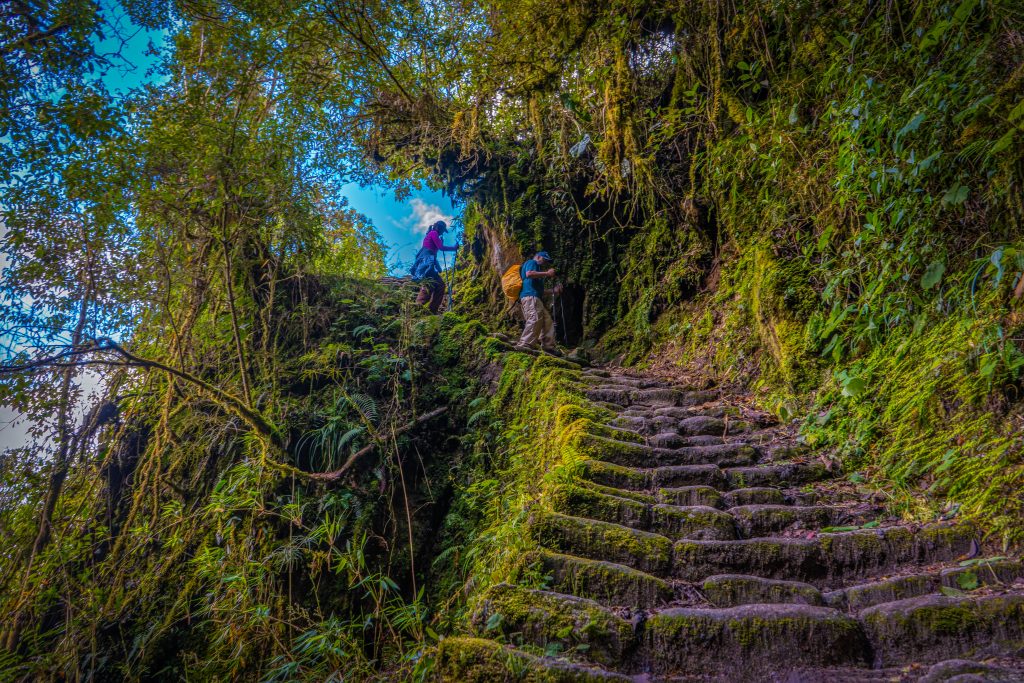Cusco is not just the starting point toward Machu Picchu. This city, located at 3,400 meters (11,155 feet) above sea level, serves as the nerve center for some of the most challenging and transformative hikes on the planet. The trails that start here are not just tourist routes. They are experiences that connect directly with the Andean heritage, push your physical limits, and redefine what it means to explore.
The geography of the Peruvian Andes combines glaciers, tropical rainforest, lagoons with unreal colors, and archaeological sites that have remained untouched for centuries. Some of these treks confront you with the silence of the highlands. Others force you to rely on your endurance when there’s no breath left. But all of them share one thing. They do not just take you to a destination. They transform you along the way. If you are looking for more than just a postcard of Machu Picchu, this guide is your starting point.

1. Classic Inca Trail
- Distance: 42 kilometers (26 miles)
- Maximum altitude: 4,215 meters (13,828 feet)
- Cost: $650–1000 USD per perso
- Reservation: Mandatory at least 6 months in advance
- Limit: 500 people per day (including guides, porters, and cooks)
- Duration: 4 days and 3 nights (classic) or 2 days and 1 night (short)
The Inca Trail is the most famous trekking route in Peru and one of the most iconic in the world because it connects directly with Machu Picchu by following the original path the Incas built over five centuries ago. The Inca Trail to Machu Picchu is a historical journey through a royal road system built to unite the empire.
Throughout its 42 kilometers (26 miles), this route crosses shifting ecosystems, from high jungle to Andean puna, reaching altitudes of over 4,200 meters (13,780 feet). Along the way, you visit key archaeological sites like Runkurakay, Sayacmarca, Phuyupatamarca, and Wiñay Wayna, all connected by original pre-Hispanic stone trails.
What makes the Inca Trail unique is that it ends at the original entrance to Machu Picchu: Inti Punku, the Sun Gate. From there, the citadel appears through the mist at dawn, just as it did for travelers centuries ago. Access is limited to 500 people per day, including porters and guides, so booking up to six months in advance is highly recommended.
2. Choquequirao: Machu Picchu’s Remote Sister
- Total distance: between 58 and 64 km round-trip (36 to 40 miles)
- Altitude: 3,050 meters (10,006 feet)
- Cumulative elevation gain: over 1,500 meters (4,921 feet) of descent and ascent per section
- Recommended duration: minimum 4 to 5 days (up to 9 if combined with other routes
- Visitors per day: between 10 and 60 people (average under 50)
- Estimated cost: $300 to $650 USD per person (depending on group and operator
- Difficulty: Advanced, requires good physical condition and acclimatization
Choquequirao is an Inca citadel built high above the Apurímac Canyon, considered the sacred sister of Machu Picchu. But here there are no trains and no crowds. The only way to reach it is by walking, through a demanding journey that crosses some of the wildest landscapes in the southern Andes. That difficulty is exactly what protects its authenticity.
The trek involves descending over 1,500 meters (4,921 feet) to the Apurímac River and then climbing steep sections back up to 3,050 meters (10,006 feet), where the site is located. The complete route is around 60 kilometers (37 miles) round-trip and includes shifting climates, steep gradients, and basic campsites. In return, it offers a pure, unfiltered Inca experience.
It is estimated that only 30 to 40 percent of Choquequirao has been excavated. What is visible now, agricultural terraces, canals, ceremonial plazas, and dwellings, is only a fraction of what remains hidden under the vegetation. Visiting this site is the most direct way to connect with the Inca worldview without intermediaries. On average, fewer than 50 people arrive each day. There is no easy access, and that makes it real and transformative.
3. Salkantay Trek
- Total distance: about 74 kilometers (46 miles) in five days
- Maximum altitude: 4,600 meters (15,092 feet)
- Altitude of the snow-capped peak: 6,271 meters (20,574 feet)
- Cost: $500 to $800 USD per person, depending on group and operator
- Duration: 4 to 6 days, five is recommendedEcosystems: glacier, puna, cloud forest, tropical jungle
- Difficulty: Intermediate to advanced, requires good physical condition and acclimatization.
- Permits: Not required for the route, only the ticket to Machu Picchu
- Visitors per day: around 50 on average, no official limit
The Salkantay Trek is one of the most powerful and complete alternatives to the Inca Trail. It usually starts in Soraypampa, near the snowy peaks of Salkantay and Humantay, and leads to Machu Picchu in four or five days through extreme ecosystems: glaciers, highlands, cloud forests, warm valleys, and tropical jungle.
The highest point is the Salkantay Pass at around 4,600 meters (15,092 feet), where the sacred mountain’s magnitude becomes overwhelming. From there, the descent into the tropical valleys is intense, moving from below-freezing nights to humid jungle heat (as high as 86 °F). No special permits are needed, only the Machu Picchu entrance ticket, making it a great option when the Inca Trail is full.
The trek is considered intermediate to advanced. It requires proper acclimatization and good fitness. Hikers usually cover 74 kilometers (46 miles) in five days. Prices range between $500 and $800 USD per person. It ends in Aguas Calientes, the town closest to Machu Picchu, from where travelers access the citadel. This route stands out for its constant landscape changes and the deep impact it leaves on those who complete it.
4. Lares Trek
- Total distance: 33 kilometers (20.5 miles)
- Maximum altitude: 4,450 meters (14,599 feet)
- Estimated cost: $350 to $700 USD per person
- Recommended duration: minimum 3 days, up to 5 depending on the route
- Difficulty: Intermediate, with three high passes and good physical condition required
- Highlight: natural hot springs at 3,800 meters (12,467 feet)
- Key communities: Lares, Huacahuasi, Patacancha, Huilloc
- Permits: Not required, only ticket to Machu Picchu
- Visitors per day: far fewer than on the Inca Trail
The Lares Trek is a high-altitude route that offers true immersion into Andean culture. Unlike the Inca Trail, there are no crowds. Only Quechua communities that preserve ancient textile, agricultural, and pastoral practices. Walking their paths is reconnecting with a more authentic Peru.
The route spans 33 kilometers (20.5 miles), reaches 4,450 meters (14,599 feet) at Ipsayccocha Pass, and descends toward traditional villages. One highlight is the natural hot springs at 3,800 meters (12,467 feet) in the town of Lares. Along the way, travelers often see birds, alpacas, and Andean landscapes that reveal daily life in its purest form.
This trek is intermediate. It requires acclimatization but no permits. Costs usually range from $350 to $700 USD per person. It ends in Ollantaytambo, where a train takes you to Aguas Calientes and Machu Picchu. It is ideal for those seeking a cultural connection alongside natural beauty and tradition.
5. Inca Jungle Trek
- Biking: 45 kilometers (28 miles) downhill
- Hiking: 15 kilometers (9.3 miles)
- Maximum altitude: 4,350 meters (14,271 feet)Cost: $300 to $700 USD per person
- Duration: 3 to 4 days
- Activities: biking, rafting, ziplining, trekking
- Difficulty: Easy to intermediate, adventure-focused
This experience combines mountain biking, rafting, ziplining, and hiking, offering an intense journey through extreme and shifting landscapes. It begins at Abra Málaga at 4,316 meters (14,160 feet), descends by bike to the Santa María area, followed by rafting on the Urubamba River, ziplining, and a final hike to Machu Picchu across four days. Its value lies in blending adrenaline, culture, and nature in one single route, ideal for travelers seeking excitement before reaching the sacred citadel.
The contrast in climate is sharp. You start in cold mountain air and end in tropical heat, often reaching 86 °F. It is a full-body adventure that impacts your mind and connects you with the Andean world in a different way.
Trek comparison table
| Trek | Total Distance (miles) | Max Altitude (feet) | Duration | Difficulty | Permits Required | Estimated Cost USD | Daily Visitors |
| Inca Trail | 26 mi | 13,828 ft | 4 days | Intermediate to advanced | Yes, reserve 6 months ahead | 650–1000 | Max 500 |
| Choquequirao | 36 to 40 mi | 10,006 ft | 5 days | Advanced | Only entry to site | 300–650 | 10 to 60 |
| Salkantay Trek | 46 mi | 15,092 ft | 5 days | Intermediate to advanced | Only Machu Picchu ticket | 500–800 | 50 to 100 |
| Lares Trek | 20.5 mi | 14,599 ft | 4 days | Intermediate | Only Machu Picchu ticket | 350–800 | Very few |
| Inca Jungle Trek | 28 mi biking + 9.3 mi hiking | 14,271 ft | 4 days | Easy to intermediate | Only Machu Picchu ticket | 300–700 | Moderate, no official cap |
A life-changing decision
These routes are not just extensions of Machu Picchu. They are living journeys that force you to understand the Andes from within. Each one has a different purpose. The Inca Trail connects you with imperial history. Choquequirao demands physical commitment and gives you a raw view of the Andean world. Salkantay overwhelms you with landscapes that never stop shifting. Lares lets you witness the daily life of real Quechua communities. Inca Jungle pushes your body, your adrenaline, and offers another way to arrive.
Waman Adventures is your ally in this decision. As a certified local operator in Peru, with years of experience in high-altitude trekking and Andean culture, we provide authentic routes, expert guides, and the logistics you need to focus on what truly matters: living the journey. If you are ready to explore the Andes from within, discover our tours to Peru and Machu Picchu.
Cusco is not just the starting point. It is where journeys that leave a mark begin.


